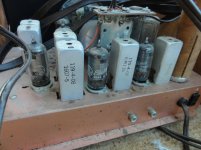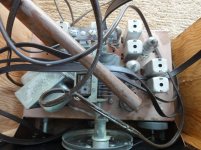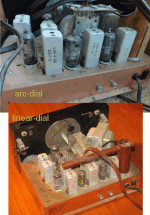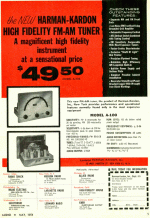I'm hoping someone can help me. We help seniors downsize, and we have this very old, and because I haven't been able to find a picture of it, maybe rare, Harman Kardon radio and ??? I don't know anything about radios, stereo equipment, etc. but am very curious about this piece of equipment. It has tubes and only three knobs, Off/Volume; AM-FM-PH and Tuning AFC and a radio dial.
Attachments
Last edited:
From the back it looks like a Harman Kardon A200
Google Image Result for https://d2ydh70d4b5xgv.cloudfront.net/images/1/3/harmon-kardon-tube-model-a-200-am-fm-tuner-and-phono-preamp-mono-0bc447c9c6f993e42e6cd537601c15f2.jpg
But not the front
Harman Kardon A200 - Manual - High Fidelity AM/FM Tuner - HiFi Engine
Google Image Result for https://d2ydh70d4b5xgv.cloudfront.net/images/1/3/harmon-kardon-tube-model-a-200-am-fm-tuner-and-phono-preamp-mono-0bc447c9c6f993e42e6cd537601c15f2.jpg
But not the front
Harman Kardon A200 - Manual - High Fidelity AM/FM Tuner - HiFi Engine
Attachments
Last edited:
I'm fairly sure it's a 1954/1955 Harman Kardon A-100 AM/FM tuner, but I can't find an image of one.
See this post.
Antique Radio Forums • View topic - help ID this 1950s Harman-Kardon integrated receiver?
See this post.
Antique Radio Forums • View topic - help ID this 1950s Harman-Kardon integrated receiver?
Last edited:
Yes, A-100, blurb from magazine attached. Also the advertisement.
A-200 is clearly the same chassis with linear dial instead of arc-dial. See attached. (200 appears to lack the volume control of the 100.)
The "wood stick" seen in beasnod's overhead photo is revealed to be the AM loopstick antenna, cleverly mounted on the main filter cap can so it may be rotated for best reception. (And is surely a phenolic fiber tube.)
A-200 is clearly the same chassis with linear dial instead of arc-dial. See attached. (200 appears to lack the volume control of the 100.)
The "wood stick" seen in beasnod's overhead photo is revealed to be the AM loopstick antenna, cleverly mounted on the main filter cap can so it may be rotated for best reception. (And is surely a phenolic fiber tube.)
Attachments
Last edited:
Wow, that's amazing. Thank you for sending the information and the old ad. So this would have been a piece of equipment you would have custom built into a cabinet? If I were to try and sell this for the owner's daughter, where/how to market and how much should I ask. You can see from the picture that it's in good condition (at least the looks), and it would be wonderful to have someone rebuild it or use it.
I suggest you join RadioMuseum Forum and try to get some interest.
They list prices as reported, but in the H/K line they only have prices for much snazzier stuff from a decade later. (Say $150-$300 range.) The older stuff is rare and does not come up often. It also is, frankly, less interesting. And this is the "crude" end of H/K's early line (note the emphasis on price). Unless you find an H/K Completist, who has-to-have one (or more) of every model, it may only get yawns.
Yes, early hi-fi was often about custom wood-work. There was an excess of local talent while the furniture racket moved to mass production. (My grandfather got caught in that market change.) While H/K may have sold an optional cabinet, some sniffing inside may suggest your cabinet was built locally to match the owner's existing furniture and woodwork.
I have picked-up similar electronics for $25 to free. The free was a wood Zenith of that same vintage, it worked (but was AM-only), and picks up stations 450 miles away better than any modern radio and nearly any vintage radio. Of course I have also walked-by tube radios with asking prices $50 and up... maybe someone pays those prices, but I think the sellers will have to work very hard to find a buyer near that price.
They list prices as reported, but in the H/K line they only have prices for much snazzier stuff from a decade later. (Say $150-$300 range.) The older stuff is rare and does not come up often. It also is, frankly, less interesting. And this is the "crude" end of H/K's early line (note the emphasis on price). Unless you find an H/K Completist, who has-to-have one (or more) of every model, it may only get yawns.
Yes, early hi-fi was often about custom wood-work. There was an excess of local talent while the furniture racket moved to mass production. (My grandfather got caught in that market change.) While H/K may have sold an optional cabinet, some sniffing inside may suggest your cabinet was built locally to match the owner's existing furniture and woodwork.
I have picked-up similar electronics for $25 to free. The free was a wood Zenith of that same vintage, it worked (but was AM-only), and picks up stations 450 miles away better than any modern radio and nearly any vintage radio. Of course I have also walked-by tube radios with asking prices $50 and up... maybe someone pays those prices, but I think the sellers will have to work very hard to find a buyer near that price.
Last edited:
From old AM tube radios I know ferrite rod antennas with one or several winding(s) on top. Neither do I recognize in the pics. So, how does this loopstick antenna work? Are the rod with the windings hidden inside the phenolic tube?
Best regards!
Best regards!
Yes the windings are inside.. PRR's comments about value are valid. I see these from time to time at hamfests here in New England, and they generally command low dollars. IMO the early HK kit gear is interesting and cool within their context. They are sort of clunky and don't fit modern hifi aesthetics particularly well. RF performance is mediocre but adequate in non fringe areas.
- Status
- Not open for further replies.
- Home
- Amplifiers
- Tubes / Valves
- Help with Identifying What My Old Harman Kardon is






